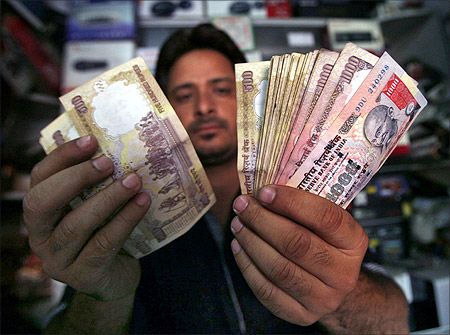Surplus in March, the last month of a financial year, has helped the government reduce fiscal deficit in the last few years, says A K Bhattacharya.
 The Union government's accounts for the first 11 months of 2015-16 were released last week.
The Union government's accounts for the first 11 months of 2015-16 were released last week.
In the context of the Budget that was presented on February 29, these numbers have significant implications for government finances.
Finance ministry mandarins would do well to take note of them and prepare appropriate policy responses.
According to these numbers, the fiscal deficit number at the end of February 2016 was estimated at 107 per cent of the revised estimates for the full year presented to Parliament on February 29.
This meant that the government would have to record a substantial surplus in March to bring down the seven-percentage-point excess in the fiscal deficit number.
For the uninitiated, this might appear a bit alarming.
But in fact, this presents a comfortable situation as far as the government's public finances are concerned, in particular, vis-a-vis the revised estimates that were presented earlier.
For instance, the fiscal deficit at the end of February 2015 was much higher at 117 per cent of the revised estimates for 2014-15 and a year previous to that the number for the end-February period was 114 per cent of the revised estimates for 2013-14.
The fact is that the surplus generated in March, the last month of the financial year, has often seen a big spurt, which in most years has resulted in a surplus for the government.
Even when the excess of deficit over the revised estimate at the end of February has been 17 per cent, as in 2014-15, the government has managed to end the year without any slippage in that year's promised fiscal deficit target of 4.1 per cent of gross domestic product (GDP).
In 2013-14, the fiscal deficit at the end of February 2014 was 14 per cent more than the revised estimate, but once again the March surplus helped the government reduce the fiscal deficit to 4.4 per cent of GDP, which was much lower than the promised 4.8 per cent.
The big question here is how the government manages to show a surplus almost every year in March.
Numbers available from Budget documents suggest that the surplus accrues largely because of bunched-up revenue collections on account of tax and non-tax dues in the last month of the year and curtailment of such portions of Plan or non-Plan expenditure that have not been committed till then or are not obligatory by nature.
In 2015-16, for instance, the targets of revised estimates for both tax and non-tax revenues have been met.
There is also a possibility that by the time the accounts are closed, total tax revenue collections could actually be much higher than what were mentioned in the revised estimates.
Even the disinvestment targets, revised downwards to Rs 25,000 crore (Rs 250 billion) from the Budget estimate of Rs 69,500 crore (Rs 695 billion), have been met, thanks to the sale of public sector undertaking shares in the last few weeks of March.
On the expenditure side also, there seems to have been some gains during 2015-16.
Plan expenditure, it appears is lower by Rs 7,000 crore, when compared to the revised estimates, though at Rs 4.7 lakh crore, it is still higher than the Budget estimate of Rs 4.65 lakh crore.
In addition, the government may have saved some amount from its subsidies outgo.
Indeed, the current situation has given rise to a debate within the finance ministry on whether the government should actually declare a revised fiscal deficit number for 2015-16 that is even lower than 3.9 per cent of GDP.
The temptation to do so is strong to establish that the government is committed to fiscal consolidation.
One option before the finance ministry is to avoid revising the fiscal deficit number down and instead use the government's savings from 2015-16 to clear the dues on subsidies or a few other heads that were deferred for payment during 2016-17.
This will provide some cushion to the government in the current year when it would not enjoy some of the gains it had in 2015-16 on account of lower subsidies expenditure, as prices of commodities including crude oil fell.
Since the battle for fiscal consolidation last year has already been won by adhering to the promised deficit target, it makes sense for the finance ministry to keep its powder dry for the current year.
The global financial situation is still uncertain and it is not clear how the Indian economy would fare amid the new challenges that it might have to face.
If the savings of 2015-16 can be judiciously used to reduce the pressure on the government to meet a fiscal deficit target of 3.5 per cent of GDP in 2016-17, the finance ministry will only be complimented for prudence and pragmatism.











